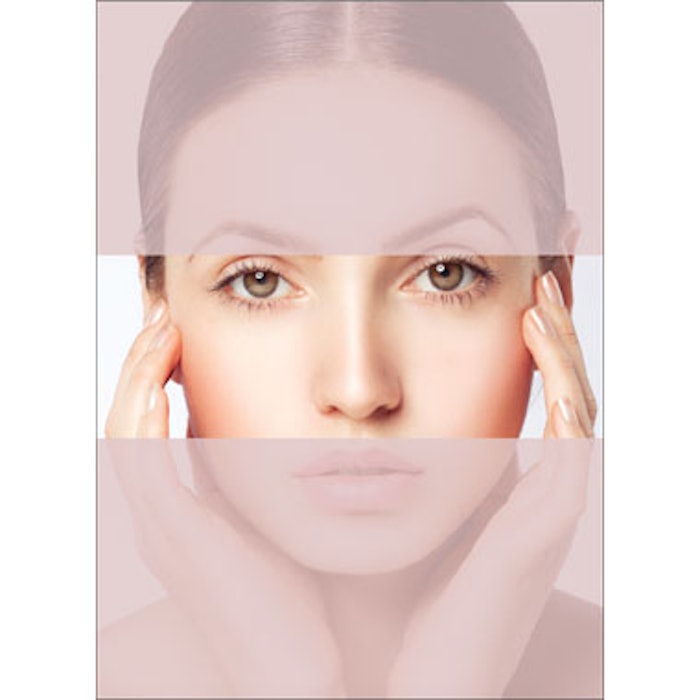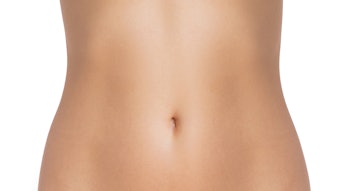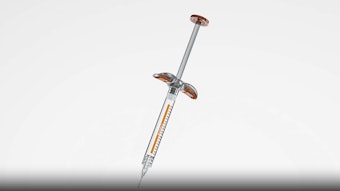
The middle third of the face extends from the infraorbital rim to the upper lip and includes the zygomatic arch and maxilla. Age-related volume loss in this area is influenced by genetics, general health and dentition—among other factors—resulting in sagging fat pads, deepening nasolabial folds, and a host of hollows and wrinkles. Until the turn of the 21st century the only way to correct these problems was plastic surgery, a solution available to only a few.
The introduction of hyaluronic acid (HA) fillers in 2004 allowed cosmetic practitioners to offer more affordable, if temporary, solutions to age-related changes in the face. Today, the ability to subtly correct midface volume loss with fillers is a burgeoning art, allowing millions of women and men to retain more youthful faces well into their 40s and 50s.
“Aging shows itself in our mid-20s, when we begin to lose volume in the cheeks and around the eyes,” says Rod J. Rohrich, MD, founding partner of Dallas Plastic Surgery Institute and chair of the Dallas Rhinoplasty Symposium. “HA fillers are a safe way to reverse these signs of aging and maintain a more youthful appearance.”
Early practitioners tended to use fillers as the name implies—to fill wrinkles and folds. Pioneers like Dr. Rohrich soon began experimenting with fillers as a way to reposition and restore aging facial structures.
“The hallmark defect of midface aging is volume loss in the deep malar fat pad below the zygomatic arch,” he says. “The goal of filler injections is to reshape the cheek, to lift and soften it. The outcome is all about highlights. For women, the cheeks need to be higher and wider than in their male counterparts.”
In some cases, filler techniques in the midface mimic those used in surgical procedures. “I often place fillers in the same vector as I would place a suture when performing a facelift,” says Melissa S. Doft, MD, founder of Doft Plastic Surgery in New York City and clinical assistant professor of surgery at Weill Cornell Medical College. “I place the fillers along the periosteum of the zygoma to define the cheek bone and create a lift and, more superficially, in the cheek to add volume.”
Refining Technique
With their ability to fill lines and create structure, soft tissue fillers are allowing practitioners to address multiple concerns and create highly customized treatment plans. “The approach to midface rejuvenation is more individualized now. It’s about harmonizing facial features at all ages,” says Hema Sundaram, MD, director of Sundaram Dermatology, Cosmetic & Laser Surgery Centers in Rockville, Maryland, and Fairfax, Virginia. “To achieve this, we must take into account the congenital baseline for each face—and the acquired disharmonies, which are most commonly due to the aging process, but can also be the result of injury or other external causes. Volume loss is a cardinal feature of aging. To make the best use of the new soft tissue fillers that are in the U.S. or on the horizon, cosmetic practitioners need to understand their unique scientific properties—how these properties influence their clinical behavior and how to combine and layer fillers for the most natural results.
“The new concept is to think dynamically,” she continues. “We need to move away from injecting clumps of filler down over the bone and into the deep subcutis and toward a more even dispersal that reflects the multi-level pattern of age-related volume loss.”
“The best treatment depends on the patient’s needs,” agrees Mitchel P. Goldman, MD, medical director of Cosmetic Laser Dermatology in San Diego. “Nasolabial folds respond to full face filling but often also require some direct filler placement. However, too much filler in this area can produce a ‘simian’ appearance.”
When mapping her treatment plan, Lorrie Klein, MD, founder of OC Dermatology in Laguna Niguel, California, looks for areas that are not reflecting light or those where shadows form. “This may include sunken eyes/tear trough hollowness, sagging cheeks, malar grooves (cheek diagonal linear depression), jawline sagging and malar festoons (bags in upper cheeks), as well as nasolabial fold lines,” she says.
One of Dr. Klein’s favorite techniques is to inject 1cc to 2cc of Juvéderm Voluma XC (Allergan) periosteally in 0.1cc to 0.2cc aliquots over several sites across the cheekbone. “This improves the appearance of the eyes, cheeks, nasolabial folds and the jawline in most patients,” she says. “My other favorite area for filler correction is under the eyes, where I use Restylane-L (Galderma) periosteally to correct the tear trough deformity and hide undereye bags.”
When it comes to the latest injection techniques, the focus is shifting for advanced practitioners to a more integrative approach.“This starts not with the midface, but with the facial frame—the peripheral zones of the face, including the forehead, brows, temples and preauricular region,” says Dr. Sundaram. “I will first volumize these areas as needed, then wait at least two to three weeks before balancing the midface. This lessens the risk of disharmony due to over-filling of the midface.”
She notes that it is often better to place newer products higher than the supraperiosteal level. “Placing them that deep is wasteful of product and unnecessary because these products are softer, more cohesive, and therefore less likely to cause lumps and bumps,” says Dr. Sundaram. “Placing this type of filler too deep not only ends up costing more; it doesn’t harness the restorative benefits of tissue integration.”
As injection techniques continue to evolve rapidly, Dr. Rohrich encourages injectors to “know before you go. There are no shortcuts in medicine, and you can’t learn everything you need to know about facial filler injections in a weekend course,” he says. “These advanced techniques take expertise and experience, especially for exceptional outcomes.”
Careful patient selection is also important. Clinical improvement is likely to be greater in patients with soft tissue loss, and outcomes are better in patients with good skin elasticity. Stressing the temporary nature of HA fillers and the possible need for additional injections to achieve desired results are essential to good patient management.
Filler Selection
Voluma XC and Restylane Lyft are two of the most recent HA fillers approved specifically for midface volume loss. They join biostimulator Sculptra (Galderma). “Newer fillers tend to flow more smoothly and last longer, but all fillers and biostimulatory agents work well when used properly,” says Dr. Goldman, who uses both Juvéderm and Restylane products. “Radiesse (Merz Aesthetics) also works well, but must be used with caution since overfilling is correctable only with time. Sculptra is one of my favorites since it produces both a natural fullness and enhances the quality of the skin through biostimulation. If immediate results are needed, Voluma or Restylane products are preferred. If a delayed, subtle improvement is needed, Sculptra is preferred.”
In some cases, Dr. Goldman will mix HA fillers and Sculptra for both immediate and long-term results. He notes that the best filler is the one with which the practitioner is most familiar.
Dr. Rohrich uses only HA fillers in the midface because of their superior safety profile and longevity. Dr. Doft concurs: “The newer fillers—Restylane Lyft and Voluma—are thicker and have a higher G prime. They also offer better longevity and provide a stronger foundation, which allows for an improved lifting effect and less deformation,” she says.
“While Juvéderm Ultra Plus, Restylane Lyft and Radiesse can help shape the cheek, I find Voluma lifts the cheek—and indirectly the nasolabial folds and jawline—more than the other fillers,” says Dr. Klein. “I also need less of it to do the same amount of filling, and it lasts longer. Patients love all of these things.”
In December 2016, Galderma added two new products to its Restylane line. Restylane Refyne was FDA-approved for the treatment of moderate to severe facial wrinkles and folds, and Restylane Defyne for the treatment of moderate to severe, deep facial wrinkles and folds. Both have been available in Europe since 2010 (where they were marketed under the brand name Emervel) and have proven safety records.
The two were developed using proprietary XpresHAn (pronounced like “expression”) Technology, which varies the degree of HA crosslinking to create more natural-looking results in the area for which the filler is indicated. To help practitioners achieve the best outcomes, the company is currently conducting three ongoing Phase 4 clinical studies to investigate the effects of Refyne and Defyne as patients conduct everyday expressions.
Juvéderm’s newest addition, Vobella XC, which gained FDA approval in June 2016, targets superficial defects such as “smoker’s lines” and can be used in much the same way as the original Juvéderm filler, although studies show it lasts longer—up to 12 months. Another Juvéderm product still in FDA trials is Volift. Like Volbella XC it combines low molecular and high molecular weight hylauronic acid, a combination that has been shown to increase HA filler longevity.
“Volift, or Volure as it may be known in the U.S., is a little softer than Voluma and has nice malleability,” says Dr. Sundaram. “Another filler family on the horizon and under study for North America is the Teosyal Resilient Hyaluronic Acid (RHA) line. One would use the Teosyal RHA-3 or RHA-4 products for the midface. Teosyal RHA-1 and RHA-2 are softer products for more superficial implantation and fine lines. These fillers integrate well into the skin and subcutaneous tissue.”
Teosyal, from Teoxane Laboratories in Switzerland, is already available in Europe. Alphaeon Corporation has U.S. distribution rights for the products, which are awaiting FDA approval.
Cost Considerations
With so many filler options now available, practitioners are able to consider not only the patient’s desired outcome and timetable, but budget as well. “I would never sacrifice an excellent result for price,” says Dr. Doft, “but when two products are equivalent, price can play a role. For example, Voluma is significantly more expensive than Restalyne Lyft. Some patients are more cost-sensitive than others; I give them the option of which filler they would prefer.”
Many doctors economize by using less filler per injection, and at least one study indicates this may be an effective approach. A two-center retrospective cohort study led by M.V. Wilson, MD, of Cosmetic Laser Dermatology in San Diego and published online October 20, 2016 (JAMA Facial Plastic Surgery) sought to assess efficacy, longevity and patient satisfaction associated with correction of age-related midface volume loss using the low volumes of HA fillers more commonly used in day-to-day practice.
For comparison, the mean injection volume of filler used in the product’s original clinical trials was 6.65ml. The mean initial treatment volume for the 61 healthy adult patients enrolled in Dr. Wilson’s study was l.6ml, and a mean touch-up volume of 1.4ml was added at a follow-up visit for the 48% of patients who requested it. At one year postprocedure, 84% of the patients reported satisfaction with their outcomes. The authors concluded that “midface volumization using the low volumes of HA filler more commonly used in daily clinical practice is effective and well tolerated.” They also suggested that injection technique could play a role in the amount of filler needed.
“I always discuss cost with patients prior to treating them,” says Dr. Klein. “If patients are on a budget, I will advise them on the best way to spend their ‘beauty dollars’ and suggest a long-term treatment plan if they can’t do everything in one day.”
Image copyright Getty Images
Linda W. Lewis is the contributing editor of MedEsthetics.











